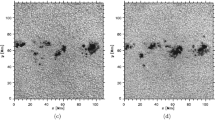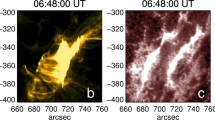Abstract
During 23–28 August 1988, at the Huairou Solar Observation Station of Beijing Observatory, the full development process of the region HR 88059 was observed. It emerged near the center of the solar disk and formed a medium active region. A complete series of vector magnetograms and photospheric and chromospheric Dopplergrams was obtained. From an analysis of these data, combined with some numerical simulations, the following conclusions can be drawn. (1) The emergence of new magnetic flux from enhanced networks followed by sunspot formation is an interesting physical process which can be simply described by MHD numerical simulation. The phenomena accompanying it occur according to a definite law summarized by Zwaan (1985). The condition for gas cooling and sunspot formation seems to be transverse field strength > 50 G together with longitudinal field strength > 700 G. For a period of 4 to 5 hours, the orientation of the transverse field shows little change. The configuration of field lines may be derived from vector magnetograms. The arch filament system can be recognized as an MHD shock. (2) New opposite bipolar features emerge within the former bipolar field with an identical strength which will develop a sunspot group complex. Also, arch filament systems appear there located in the position of flux emergence. The neutral line is often pushed aside and curved, leading to faculae heating and the formation of a current sheet. In spite of complicated Dopplergrams, the same phenomena occur at the site of flux emergence as usual: upward flow appears at the location of the emerging and rapidly varying flux near the magnetic neutral line, and downdraft occurs over large parts of the legs of the emerging flux tubes. The age of magnetic emerging flux (or a sunspot) can be estimated in terms of transverse field strengths: when 50 G < transverse field < 200 G, the longitudinal magnetogram and Dopplergram change rapidly, which indicates a rigourously emerging magnetic flux. When the transverse field is between 200 and 400 G, the area concerned is in middle age, and some of the new flux is still emerging there. When the transverse field > 400 G, the variation of the longitudinal magnetogram slows down and the emerging arch becomes relatively stable and a photospheric Evershed flow forms at the penumbra of the sunspot.
Similar content being viewed by others
References
Ai, G., Li, W., and Zhang, H.: 1982, Acta Astron. Sinica 23, 39.
Bruzek, A.: 1967, Solar Phys. 2, 451.
Bruzek, A.: 1969, Solar Phys. 8, 29.
Fyfe, D. E., Oran, E. S. and Fritts, M. I.: 1988, J. Comp. Phys. 76, 349.
Harvey, K. L. and Martin, S. F.: 1973, Solar Phys. 32, 389.
Schoolman, S. A.: 1973, Solar Phys. 32, 379.
Shestakov, A. I., Harte, J. A. and Kershaw, D. S.: 1988, J. Comp. Phys. 76, 385.
Shibata, K., Tajima, T., Steinolfson, R. S. and Matsumoto, R.: 1989, Astrophys. J. 345, 584.
Song, M. T. and Zhang, H. Q.: 1991, Acta Astrophys. Sinica (submitted).
Wang, H. M., Zirin, H., and Ai, G. X.: 1991, Solar Phys. 131, 53.
Zhang, H.: 1986, Acta Astrophys. Sinica 6, 295.
Zhang, H. Q. and Al, G.: 1986, Acta Astrophys. Sinica 27, 217.
Zirin, H.: 1972, Solar Phys. 22, 34.
Zirin, H.: 1974, in R. G. Athay (ed.), ‘Chromospheric Fine Structure’, IAU Symp. 56, 161.
Zirin, H.: 1987, Solar Phys. 114, 239.
Zwaan, C.: 1985, Solar Phys. 100, 397.
Author information
Authors and Affiliations
Rights and permissions
About this article
Cite this article
Hongqi, Z., Mutao, S. Vector magnetogram and dopplergram observation of magnetic flux emergence and its explanation. Sol Phys 138, 69–92 (1992). https://doi.org/10.1007/BF00146197
Received:
Revised:
Issue Date:
DOI: https://doi.org/10.1007/BF00146197




